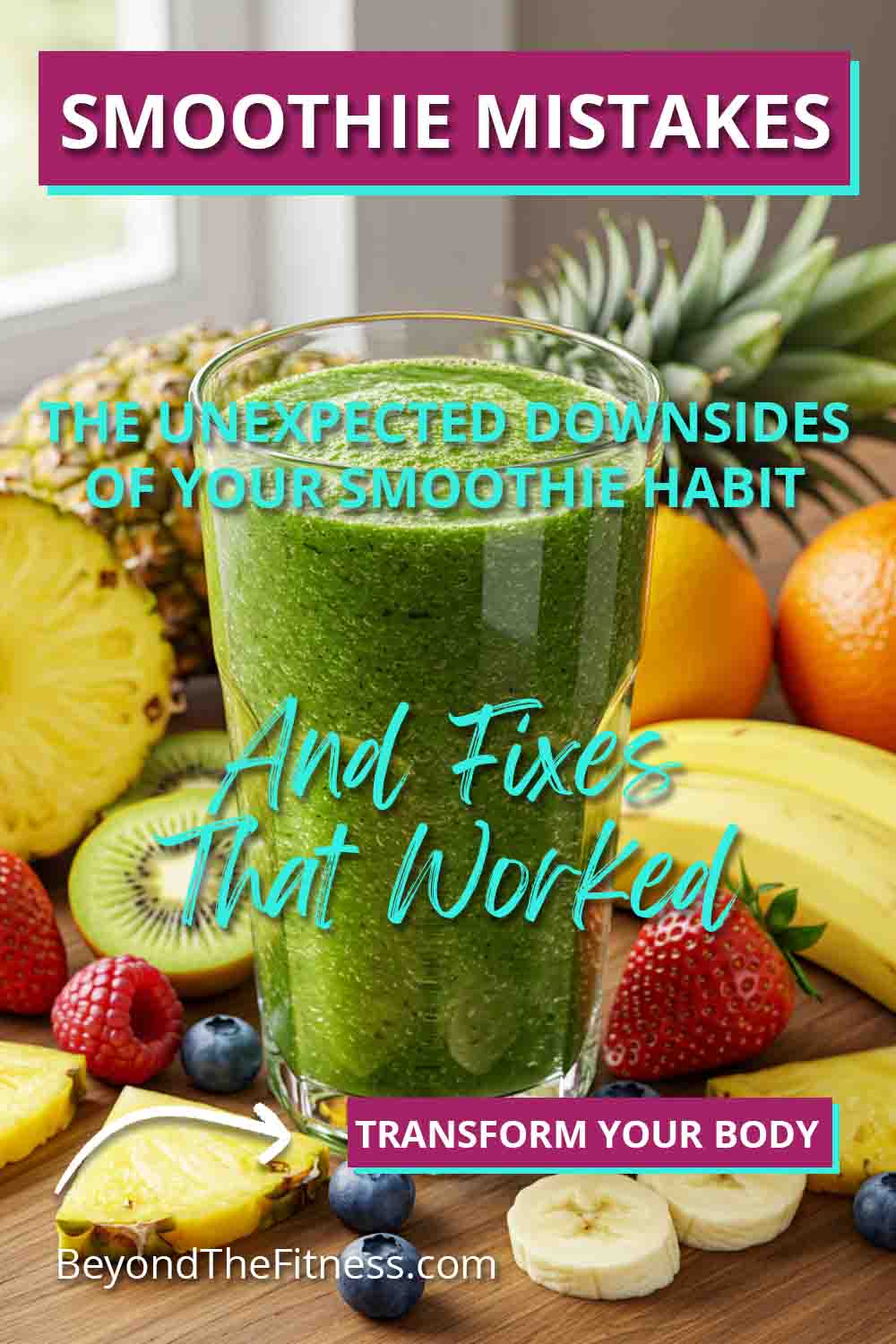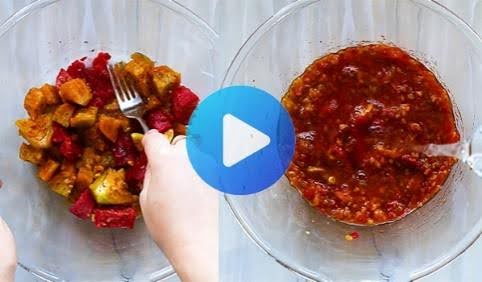Smoothies seem like such a great idea, right. You toss a bunch of fruits and maybe some veggies into a blender, and you get a quick, easy drink. Many people think this is a super healthy habit. I used to think that too. But, like many things that seem perfect, smoothies can have some downsides if we are not careful. As a fitness writer and weight loss consultant, I have seen how some popular health trends can sometimes lead us astray if we do not understand them fully.
I want to talk to you about some of these surprising problems with drinking smoothies all the time. More importantly, I want to share how you can fix these issues. This way, your smoothie can be a truly healthy part of your eating plan, especially if you are a woman trying to manage your weight or just feel your best.
The Sneaky Sugar Trap
One of the biggest surprises for many people is how much sugar can be hiding in their healthy smoothie. We often think of fruit as pure goodness, and it is, in many ways. Fruits have vitamins and fiber. But they also have natural sugars. When you blend a lot of fruit into a smoothie, you are concentrating that sugar.
Think about it. You might eat one orange or a handful of berries. But in a smoothie, you might use two or three oranges, a banana, and a big cup of mango. That is a lot of fruit, and so, a lot of sugar, all at once. Even though it is natural sugar, your body still has to process it. For women, managing blood sugar is really important for energy levels and even for hormone balance. Too much sugar can lead to a quick burst of energy followed by a crash. This can make you feel tired and crave even more sugar.
Sometimes, the sugar problem is not just from the fruit. Many people add things like flavored yogurts, fruit juices, honey, or maple syrup to their smoothies to make them taste sweeter. These things add even more sugar. Store-bought smoothies can be some of the worst offenders. They often have a lot of added sugars and syrups that you might not even realize are there. This sugar overload can make it harder to lose weight. In fact, it can even lead to weight gain if you are not careful. Your body uses the energy it needs and stores the extra sugar as fat.
The Calorie Creep
Another thing that can catch people off guard is the number of calories in a smoothie. Because smoothies are drinks, we sometimes do not think of them as being very filling or having a lot of calories. But they can pack a punch.
When you blend ingredients, you can fit a lot more food into the glass than you would probably eat if the food was whole. For example, a large smoothie could have a banana, a cup of berries, a scoop of peanut butter, a cup of milk, and maybe some oats. If you were to eat all those things separately, it would feel like a big meal. But when it is all blended up, it goes down pretty easily.
This is not always a bad thing. If you are using a smoothie to replace a meal, then having enough calories is important. But if you are having a smoothie as a snack, or along with your regular meals, the calories can add up quickly. This is especially true if you are trying to lose weight. To lose weight, you need to burn more calories than you eat. If your smoothie is adding an extra 300, 400, or even 500 calories to your day without you realizing it, it can stop your weight loss progress.
For women, calorie needs can change based on age, activity level, and hormonal changes. It is easy to think a smoothie is a light choice, but it is important to be aware of what is going in it and how that fits into your daily calorie goals.
Where Did the Fiber Go
Fiber is super important. It helps with digestion, keeps you feeling full, and can help manage blood sugar levels. Whole fruits and vegetables are great sources of fiber. But what happens to that fiber in a smoothie.
Well, it depends on your blender and what parts of the fruit and veggies you use. Some very powerful blenders can break down the fiber so much that it might not work in your body the same way as fiber from whole foods. Also, if you peel your fruits and vegetables, like apples or cucumbers, you are removing a lot of the fiber which is often in the skin.
When you drink your calories instead of eating them, your body might also process them faster. Chewing food sends signals to your brain that you are eating and helps you feel satisfied. With a smoothie, you can drink it quickly, and those signals might not be as strong. This means you might feel hungry again sooner than if you had eaten the same foods whole.
For women who might be dealing with digestive issues like bloating or constipation, getting enough fiber is key. If your smoothies are low in fiber, they might not be helping as much as you think. It is also fiber that helps slow down sugar absorption, which, as we talked about, is important for stable energy.
The Nutrient Balancing Act
A good meal should have a balance of carbohydrates, protein, and healthy fats. Carbohydrates give you energy, protein helps build and repair tissues and keeps you full, and healthy fats are important for brain health, hormone production, and absorbing certain vitamins.
Many smoothies, especially if they are mostly fruit, are very high in carbohydrates (from the sugar in fruit) but low in protein and fat. If your smoothie is all fruit and maybe some fruit juice, it is not a balanced meal. This can leave you feeling hungry soon after and can also contribute to those blood sugar ups and downs.
Protein is especially important for women, particularly if you are active or trying to maintain muscle mass as you age. Muscle helps burn more calories even when you are resting. If your smoothie is your breakfast or lunch, and it lacks protein, you are missing a key opportunity to fuel your body properly. Healthy fats are also crucial for women’s health, playing a role in hormone regulation and overall well-being. Things like avocado, nuts, and seeds can add these good fats, but they also add calories, so it is a balance.
Tummy Troubles
Have you ever felt a bit bloated or had an upset stomach after a smoothie. You are not alone. For some people, smoothies can cause digestive discomfort.
You Might Be Interested In: Learning more about The Complete Smoothie Detox & Weight Loss Program
One reason can be the temperature. Very cold drinks can sometimes be a shock to your digestive system, especially if you drink them quickly. This can slow down digestion for some individuals.
Another reason is how quickly we tend to drink smoothies. When you eat whole foods, you chew them. Chewing starts the digestive process by mixing food with saliva, which has enzymes that begin breaking down food. When you drink a smoothie, you often bypass much of this initial chewing process. This means your stomach has to do more work.
Also, if you are putting lots of different things in your smoothie, especially things your body might not be used to, it can sometimes lead to gas or bloating. For example, if you suddenly add a lot of fiber from chia seeds or flax seeds when you are not used to it, your gut might need some time to adjust. Some people also find that blending certain fruits and vegetables together can cause issues for them personally.
The Blood Sugar Rollercoaster
We have touched on this, but it is worth its own spot because it is so important, especially for women managing energy and cravings. When you drink a smoothie that is high in sugar and low in fiber and protein, your blood sugar can go up very quickly. This gives you that initial rush of energy.
But what goes up must come down. After that spike, your blood sugar can drop just as quickly. This is the “crash”. When your blood sugar crashes, you can feel tired, irritable, shaky, and have strong cravings for more sugary foods or caffeine to pick you back up. This cycle can make it really hard to stick to a healthy eating plan and can mess with your mood and productivity.
For women, stable blood sugar is also linked to better hormonal balance. Big swings in blood sugar can put stress on your body and potentially affect your menstrual cycle or symptoms related to hormonal changes like PMS or menopause. So, a smoothie that sends you on a blood sugar rollercoaster might be doing more harm than good in the long run.
Not So Smiley for Your Teeth
This is one that many people never think about. Smoothies, especially those high in fruit, can be quite acidic and sugary. When you sip on a smoothie over a long period, or if you do not rinse your mouth afterwards, the sugars and acids can sit on your teeth.
The bacteria in your mouth love sugar. They feed on it and produce acids. These acids can wear away at the enamel on your teeth. Enamel is the hard, protective outer layer of your teeth. Once it is gone, it does not come back. This can lead to tooth sensitivity and cavities over time.
Even if your smoothie is made with only “natural” sugars from fruit, it can still have this effect. The stickiness of some blended fruit can also mean it clings to your teeth more easily. It is something to be mindful of if smoothies are a daily habit.
Missing Out on Mindful Eating
Eating should be an enjoyable and mindful experience. When we sit down to a meal of whole foods, we engage more of our senses. We see the different colors and textures, we smell the aromas, and we take the time to chew and savor the flavors. This process of mindful eating helps our bodies register fullness and satisfaction.
When you drink a smoothie, especially if you are having it on the go or gulping it down quickly, you can miss out on this experience. It becomes more about just getting fuel in, rather than enjoying the process of eating. While convenience is great, always opting for a liquid meal might mean you are not as satisfied as you would be if you ate those ingredients in their whole form. This lack of satisfaction can sometimes lead to looking for other foods soon after, even if the smoothie was calorically adequate.
The Cost Factor
Let’s be honest, making healthy smoothies can sometimes get expensive. If you are buying organic fruits and vegetables, special protein powders, superfood add-ins like goji berries or maca powder, and fancy nut milks, the cost can add up quickly.
Buying pre-made smoothies from a shop is almost always more expensive than making them at home. While investing in your health is important, it is also good to be realistic about your budget. If your smoothie habit is straining your wallet, it might not be sustainable in the long term. There are ways to make healthy smoothies more affordable, but it requires some planning.
How to Make Your Smoothie Habit Healthier
Okay, so now that we know some of the potential downsides, let’s talk about how to fix them. I am not saying you should give up smoothies. They can still be a great way to get lots of nutrients. You just need to be a bit smarter about how you make them.
1. Slash the Sugar
- More Veggies, Less Fruit: This is the number one rule. Try to make your smoothie at least half vegetables. Spinach and kale are great because they have a mild flavor and blend well. Cucumbers, celery, and zucchini are also good low-sugar options.
- Choose Low-Sugar Fruits: Opt for berries (strawberries, blueberries, raspberries), which are lower in sugar and high in antioxidants. Limit high-sugar fruits like mangoes, pineapples, and too many bananas. A small piece of banana can add creaminess, but you do not need a whole one.
- Unsweetened Liquids: Use unsweetened almond milk, unsweetened soy milk, or just plain water as your base instead of fruit juices or sweetened milks.
- No Added Sweeteners: Skip the honey, maple syrup, agave, or table sugar. If you need a little sweetness, a few dates can work, but use them sparingly. Your taste buds will adjust over time.
2. Control the Calories
- Portion Sizes: Be mindful of how much of each ingredient you are adding. Use measuring cups and spoons, at least initially, to get an idea of your portions.
- Mindful Add-Ins: Things like nuts, seeds, nut butters, and avocado are healthy fats, but they are also high in calories. A tablespoon of nut butter is usually plenty.
- Smoothie as a Meal or Snack: Decide if your smoothie is replacing a meal or if it is a snack. If it is a meal, it can be larger and more calorie-dense. If it is a snack, keep it smaller and lighter.
3. Boost the Fiber
- Keep the Skins On: When possible, leave the skins on fruits and vegetables like apples, pears, and cucumbers. This is where a lot of the fiber is.
- Add Fiber-Rich Seeds: Include a tablespoon of chia seeds, flax seeds (ground is best for absorption), or hemp seeds. These also add healthy fats and some protein.
- Oats for Thickness and Fiber: A quarter cup of rolled oats can add fiber and make your smoothie more filling.
- Don’t Over-Blend: Blend until smooth, but you do not need to pulverize it for minutes on end. Some texture is good.
4. Balance Your Nutrients: Protein and Healthy Fats are Key
- Add Protein: This is so important, especially for women.
- Protein Powder: Unsweetened whey, casein, soy, pea, or rice protein powders are easy options. Choose one with minimal ingredients.
- Greek Yogurt: Plain, unsweetened Greek yogurt is packed with protein.
- Cottage Cheese: Another great protein source, and it makes smoothies creamy.
- Tofu: Silken tofu blends well and adds plant-based protein.
- Include Healthy Fats:
- Avocado: Half a small avocado adds creaminess and healthy fats.
- Nuts and Seeds: Almonds, walnuts, pumpkin seeds, sunflower seeds (or their butters). Remember portion control.
- Flaxseed Oil or Coconut Oil: A teaspoon can add healthy fats, but use sparingly due to calorie density.
5. Be Kind to Your Tummy
- Sip Slowly: Do not gulp your smoothie down. Take your time.
- “Chew” Your Smoothie: Swish it around in your mouth a bit before swallowing. This can help stimulate saliva production and the start of digestion.
- Not Too Icy: If very cold drinks bother you, use chilled fruit instead of frozen, or let your smoothie sit for a few minutes before drinking.
- Listen to Your Body: Pay attention to how different ingredients make you feel. If something consistently causes bloating, try removing it.
6. Stabilize Your Blood Sugar
- The Magic Trio: The key here is to always include protein, healthy fats, AND fiber in your smoothie along with your carbohydrates (fruits/veggies). This combination slows down the absorption of sugar, preventing those spikes and crashes.
- Limit High-Glycemic Fruits: As mentioned, be cautious with fruits like very ripe bananas, pineapple, and dates if you are sensitive to blood sugar swings.
- Timing Matters: For some women, having a smoothie first thing in the morning on an empty stomach might lead to a quicker sugar rush. You might find it better after a workout or as a later meal when your system is more active.
7. Protect Your Pearly Whites
- Rinse with Water: After you finish your smoothie, rinse your mouth with plain water. This helps wash away some of the sugars and acids.
- Don’t Sip All Day: Try to drink your smoothie in one sitting rather than sipping on it for hours. Constant exposure to sugar and acid is what causes damage.
- Wait to Brush: It sounds counterintuitive, but do not brush your teeth immediately after having something acidic (like a fruit smoothie). The acid can soften your enamel, and brushing right away can be abrasive. Wait at least 30 minutes, or just rinse with water.
8. Embrace Whole Foods Too
- Smoothies as Part of a Varied Diet: Do not let smoothies become your only source of fruits and vegetables. It is still important to eat whole foods. The act of chewing and the way your body digests whole foods offer unique benefits.
- Mindful Meal Replacement: If you use a smoothie as a meal replacement, make sure it is truly balanced and satisfying. If not, you might be better off with a small whole-food meal.
9. Smoothie Smart on a Budget
- Frozen Fruits and Veggies: Buying frozen fruits and vegetables is often cheaper than fresh, especially for items that are out of season. They are just as nutritious.
- Seasonal Produce: Buy fresh fruits and veggies when they are in season and more affordable. You can buy extra and freeze it yourself.
- Simple Ingredients: You do not need a dozen expensive “superfood” powders to make a healthy smoothie. Focus on the basics: greens, a bit of fruit, a protein source, and a healthy fat.
- Make it at Home: This is almost always cheaper than buying from a smoothie bar.
Special Thoughts for Women
As women, our bodies have unique needs. Hormonal fluctuations can affect our energy, mood, and appetite. Paying attention to how food makes us feel is really important.
- Hormone Harmony: Balancing blood sugar, as we have discussed, is crucial for hormone health. Smoothies that are high in sugar and low in protein/fat can disrupt this. Adding things like maca powder (in moderation, and if it suits you) or focusing on good fats from avocado or seeds can be supportive for some women.
- Iron Intake: If you are making green smoothies with spinach, that is great for iron. To help your body absorb that plant-based iron better, include a source of Vitamin C in your smoothie, like berries or a small squeeze of lemon juice.
- Calcium: If you use dairy like Greek yogurt or milk, or fortified plant milks, smoothies can be a good way to get calcium, which is vital for bone health throughout a woman’s life.
- Listen to Your Cycle: You might find your cravings or energy levels change throughout your menstrual cycle. Adjust your smoothies accordingly. Maybe you need a bit more healthy fat or protein at certain times of the month.
Smoothies can be a fantastic tool for health and weight management, but they are not automatically healthy just because they contain fruit. By being aware of these potential downsides and making smart choices about your ingredients and how you consume them, you can turn your smoothie habit into a truly beneficial one. It is all about being informed and listening to your body.
Related YouTube Video
For more tips on making healthy smoothies, you might find this video helpful:
Final Thoughts
Making small changes to your smoothie routine can make a big difference. It is not about perfection, but about progress. Think of your smoothie as an opportunity to pack in good nutrition in a way that supports your energy, your weight goals, and your overall well-being as a woman. Start with one or two of these tips and see how you feel. You have got this.







